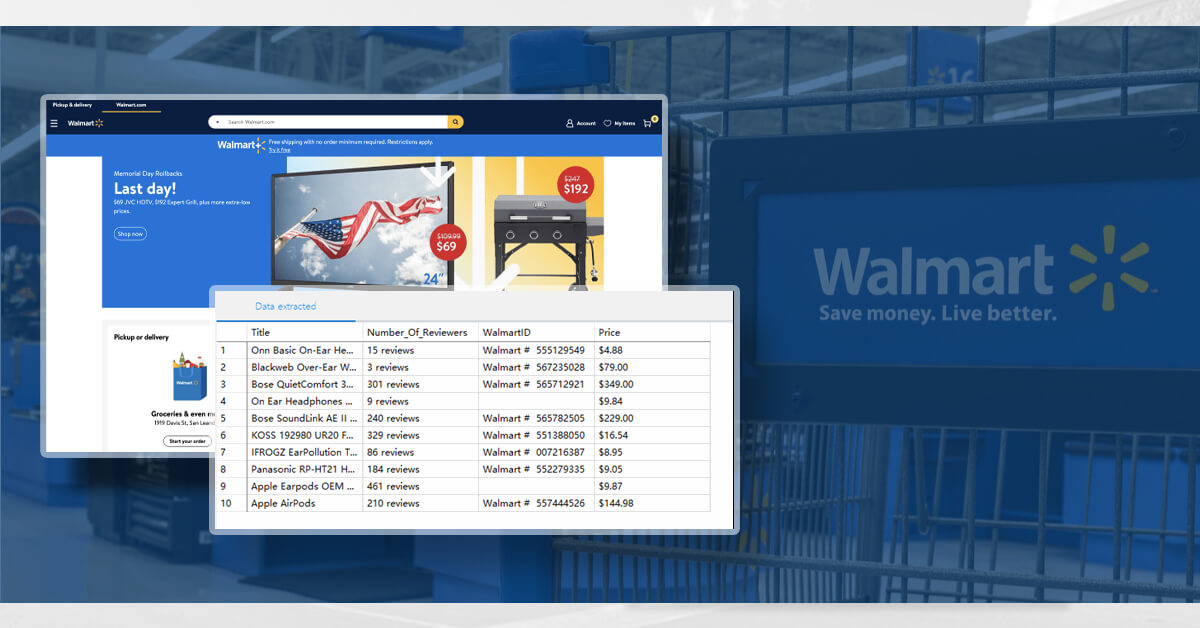How Web Scraping is Used for Scraping E-Commerce Data from Walmart – The World’s Biggest Retail Store?

As of July 2021, Walmart had 20,000 outlets across 28 nations. It continues to be the biggest retailer in the entire globe, with Amazon following in second with more than half of its sales. Even though the company was established in 1962, it has strengthened its technical efforts, which has attracted many new players to the market in its wake. It is also one of the corporations that uses data the most, enabling data-driven decision-making in its boardrooms.
It started building the largest private cloud in the world in 2021, with a capacity of 2.5 petabytes (2500Tb) of data processing per hour. To deal with this enormous amount of data, it has also set up an analytics Center called Data Café in its Bentonville, Arkansas headquarters. At this hub, more than 200 internal and external data streams and 40 petabytes of transactional data may be transformed, visualized, or used to create models. The firm has been able to identify trends and make decisions more quickly by cutting the time it takes to crunch data from weeks to minutes. This has decreased the amount of time it takes to apply data effectively.
Walmart and Big Data

E-commerce sites and merchants typically use internal and external data sources for dynamic price control (competitor data). Walmart uses its data sources for a variety of objectives, although this is the default (and sometimes the only) use case for most businesses.
Customizing Shopping Experience
Similar to how Netflix utilizes your prior use data to provide you with a customized experience and recommendations, Walmart leverages your past data to highlight products and offers that may be more relevant to you. This encourages customer interaction and, frequently, larger purchase quantities.
Supply Chain Management

Everything undergoes a series of operations, each involving a different form of transportation. By reducing the number of steps in the supply chain as much as possible and adjusting truck schedules to ensure that their cargo space is completely utilized, Walmart tries to optimize it. Even routes and times are researched to find the best way for customers to get their items as quickly as feasible.
Instantly Restocking Pharmacies

Combining internal and historical data, generates simulations and accurately forecasts specific data points. Here are a few examples:
- What time of day sees the highest foot traffic in stores?
- On the busiest days of the month or year, which pharmaceuticals are most in- demand?
- Each prescription takes less time to fill as a consequence of the efficient management of staff and pharmaceuticals made possible by all of this data.
Optimizing Product Options

To make sure that its stores and warehouses have the finest selection of brands and products on the shelf, it makes use of data from both online and offline sales. To make its internal brands more publicly available, it also tries to determine which ones are the most well-liked by consumers.
Data Points and Sources

A good strategy for capturing the public's attention in a topic is to present use examples. The data points being acquired and the sources of these data streams are what we need to focus on the most.
Along with an online presence, Walmart has a substantial international reach. Because of this, it may get data from several sources.
- 10 active websites and 10,900 physical businesses are visited daily by 245 million people worldwide.
- Social media platforms acquire 300,000 mentions and tags per day.
- About 50,000 new employees are hired by Walmart each year, and their combined internal data helps the corporation to improve hiring practices and offer better working circumstances.
- Information about 145 million American customers, 60% of whom are adults.
Creating Competitive-edge from Data

Every business runs into data concerns when dealing with fresh datasets or trying to solve fresh problems using data. In 2014, Walmart seeks to find a rapid method for forecasting sales using a little quantity of historical data. It held a contest on Kaggle and supplied sales information from 45 real establishments in a variety of categories. Sales on holidays and during the course of the Christmas season were also included in the study.
Implementing Walmart’s Data Policies

You must first decide which department you want to concentrate on if you want to scrape product or price data from Walmart. It could be a tremendous task to gather all the data from every department. It's also a smart idea to scrape local data if you operate in a certain geographic area. It would be a waste of time and computer resources to collect all the data and then filter it.
Get in touch with iWeb Scraping for any kind of web scraping services!
Request for a quote!
